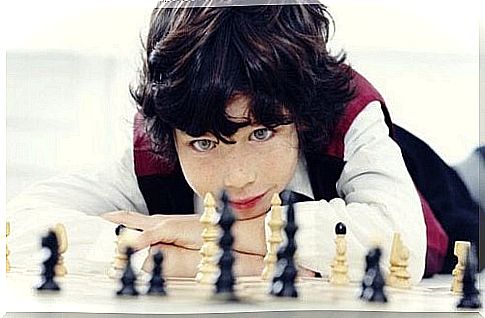Divergent Thinking In Children: A Neglected Ability

Divergent thinking in children is an exceptional and natural gift (no one has yet told them what is normal and, therefore, what is not). Their open mind is full of possibilities, unusual, original and always idiosyncratic reasoning. However, this creative potential sometimes tends to die out as children get older. On the other hand, the education system tends to normalize the way of thinking of its students and to unify perspectives.
We all know that daring to think differently can be dangerous. Galileo, for example, understood this at his expense because of his ideas. He had to end his life confined to his house in Florence. Open minds are the ones who challenge the world, no doubt, but they are also the ones who help it move forward.
Obviously times have changed. However, there are other types of situations. As Sir Ken Robinson, a recognized education expert, points out, schools today “kill” children’s creativity.
According to him, our schools base their curricular models on 19th century systems. At a time when the industrialization of society has made some capabilities more valuable than others. The promotion of innovation, creativity or critical thinking was (and often is) unusual when there is a very rigid hierarchy of subjects and skills to be assumed.
We forget that children come into the world “endowed” with extraordinary talents. We overlook the potential of their divergent thinking, that extraordinary psychic muscle. A muscle that we sometimes weaken by educating them exclusively in convergent thinking.
“It’s not what you look at that matters, it’s what you see.”
-Henry David Thoreau-

Divergent thinking in children
Henry David Thoreau was undoubtedly one of the most revolutionary philosophers. His unusual ideas about freedom and responsibility made him one of those figures still carried by a clearly divergent thought. Returning from time to time to his texts is undoubtedly a way to find inspiration in many senses.
He taught us that life is a canvas for the imagination. He also made us see that there are people who are born with a different music in them. And that we must, however, let them be. According to him , freedom leads to self-realization. It’s almost the same with children. However, we are not always able to understand this magical melody. It should be noted that sometimes it is impossible for us to discern the incredible potential that is hidden in every child.
For example, Dr. Len Brzozowski, one of the experts in the field, points out something interesting that he discovered when he conducted a study with psychologists George Land and Beth Jarman. The data from this work was published in the book Break Point and Beyond: Mastering the Future Today.
Divergent thinking in 5-year-olds greatly resembles the thinking of an adult with high intellectual capacities. So when children at this age are asked how many uses a cup, pencil or shoe has, they can give up to 100 (valid) responses. For comparison, an adult usually gives an average of 10-12 responses.
However, if we pass the same divergent thinking test to a 10-year-old child, we can see that this potential is reduced (by 60% on average).
Preschoolers are true geniuses
Divergent thinking in 4-6 year olds shows amazing scores. We must refer here to what Álvaro Pascual-Leone, professor of neurology at Harvard Medical School, tells us. Throughout early childhood, “synaptic pruning” occurs in the brain.
This is a period marked by the sensitivity of the nervous system, which has a programmed size that can only be changed by experience. If there are no adequate stimuli, over time this cell size will limit much of a child’s learning potential.
It’s not about having “a lot of neural connections” either, because the brain is then subjected to too much “noise” (which happens in autism spectrum disorders). The main thing is to optimize this size with the most appropriate, optimal learning and stimulation. Especially between 4 and 6 years old, where children have their full potential.
How can we protect and strengthen divergent thinking in children?
Divergent thinking in children requires special learning needs. These must be satisfied for learning to be effective. Indeed, children:
- Need immersion learning: they must experience, feel, touch … They must do it in groups with their peers but also alone, to encourage independent work (and their own space for creativity)
- Must work on learning, where there is not (as far as possible) a single valid answer. Divergent thinking can generate multiple options for the same challenge. The fact that children’s ideas are often punished and labeled as “bad” or “wrong” will lead to demotivation
- Must feel emotionally validated: Feeling that they are accepted, respected, valued and loved will help them feel free. They will be overwhelmed by this feeling of freedom. The freedom to explore, to discover new interests, to evoke answers, ideas and reasoning knowing that they will not be criticized.

Finally, it should be noted that the promotion and protection of divergent thinking does not imply the complete elimination of convergent thinking. Far from there. In reality, it is a question of harmonizing the two dimensions. Sometimes there are issues that require a unique solution. Children also need to understand these types of situations.
So let’s be able to take charge of and optimize these realities. Let us remember the well-known phrase from Albert Einstein: “Everyone is a genius. But if you judge a fish by its ability to climb a tree, it will spend its life believing it to be stupid ”.










